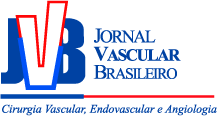Influência da altura do salto de sapatos na função venosa da mulher jovem
Influence of shoe heel height on venous function in young women
Wagner Tedeschi Filho; Carlos Eli Piccinato; Takachi Moriya; Edwaldo E. Joviliano; Nei R. A. Dezotti
Resumo
Palavras-chave
Abstract
Keywords
References
Hansen L, Winkel J, Jorgensen K. Significance of mat and shoe softness during prolonged work in upright position: based on measurements of low back muscle EMG, foot volume changes, discomfort and ground force reactions. Appl Ergon. 1998;29:217-24.
Krijnen RM, de Boer EM, Ader HJ, Bruynzeel DP. Venous insufficiency in male workers with a standing profession: Part 1: epidemiology. Dermatology. 1997;194:111-20.
Wakeling JM, Pascual SA, Nigg BM. Altering muscle activity in the lower extremities by running with different shoes. Med Sci Sports Exerc. 2002;34:1529-32.
Krijnen RM, de Boer EM, Ader HJ, Bruynzeel DP. Venous insufficiency in male workers with a standing profession: Part 2: diurnal volume changes of the lower legs. Dermatology. 1997;194:121-6.
Ozdemir H, Urguden M, Ozgorgen M, Gur S. The relationship between the thickness and elasticity of the heel pad and heel pain. Acta Orthop Traumatol Turc. 2002;36:423-8.
Drerup B, Hafkemeyer U, Moller M, Wetz HH. Effect of walking speed on pressure distribution of orthopedic shoe technology. Orthopade. 2001;30:169-75.
King PM. A comparison of the effects of floor mats and shoe in-soles on standing fatigue. Appl Ergon. 2002;33:477-84.
Porter JM, Moneta GL. Reporting standards in venous disease: an update. International Consensus Committee on Chronic Venous Disease. J Vasc Surg. 1995;21:635-45.
Dezotti NRA. Estudo da hemodinâmica venosa por meio da pletismografia a ar no pré e pós- operatório de varizes dos membros inferiores. .
Criado E, Passman MA. Physiologic assessment of the venous system. Vascular surgery. 2000:165-91.
Evangelista SSM. Plestimografia no estudo das doenças venosas. Doenças vasculares periféricas. 2002:479-92.
Conover WJ. Practical nonparametric statistics. 1997.
Celestino RTS, Castro AA, Pitta GBB, Miranda Jr. F. Volume venoso nos membros inferiores em primigestas através da pletismografia a ar. J Vasc Bras. 2005;4:167-70.
Gaspar RA. Pletismografia a ar. J Suplência Vasc News. 2001;1:10.
Yang D, Vandongen YK, Stacey MC. Variability and reliability of air plethysmographic measurements for the evaluation of chronic venous disease. J Vasc Surg. 1997;26:638-42.
Christopoulos D, Nicolaides AN, Cook A, Irvine A, Galloway JM, Wilkinson A. Pathogenesis of venous ulceration in relation to the calf muscle pump function. Surgery. 1989;106:829-35.
Engelhorn CA, Beffa CV, Bochi G, Pullig RC, Picheth FS, Cunha SS. Avaliação por pletismografia a ar da função da bomba muscular da panturrilha conforme a idade. J Vasc Bras. 2003;2:13-6.
Lima RCM, Santiago L, Moura RMF. Efeitos do fortalecimento muscular da panturrilha na hemodinâmica venosa e na qualidade de vida em um portador de insuficiência venosa crônica. J Vasc Bras. 2002;1:219-26.
Belczak CEQ. Responsabilidade das bombas músculo-veno-articulares distais na gênese de estase venosa. Úlceras nos membros inferiores: diagnóstico e terapêutica. 2002:93-103.
Canestri EA, Sánchez CF, Tropper UP. Tratado de flebologia y linfologia: Capítulo 4. Fisiologia y fisiopatologia. 1997:24.
Back TL, Padberg FT Jr., Araki CT, Thompson PN, Hobson RW 2nd. Limited range of motion is a significant factor in venous ulceration. J Vasc Surg. 1995;22:519-23.



